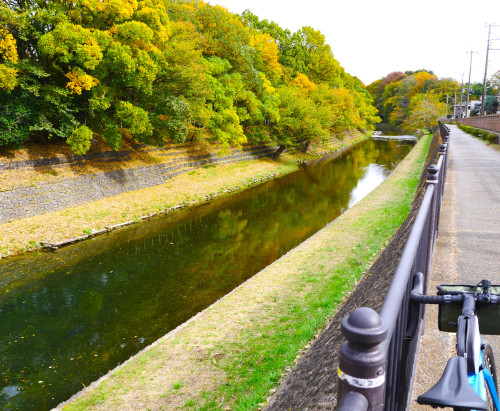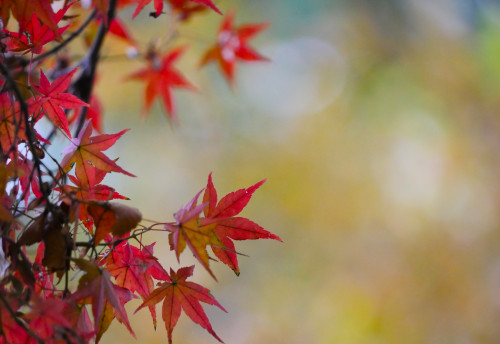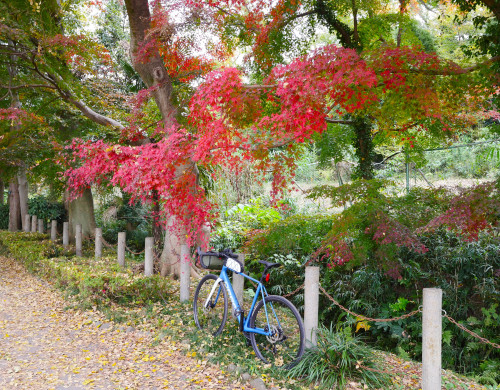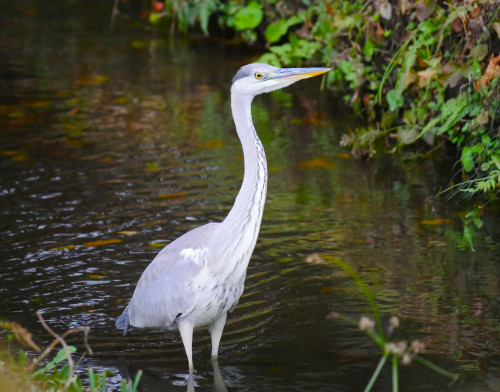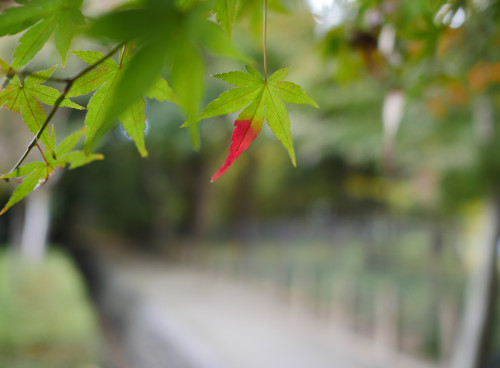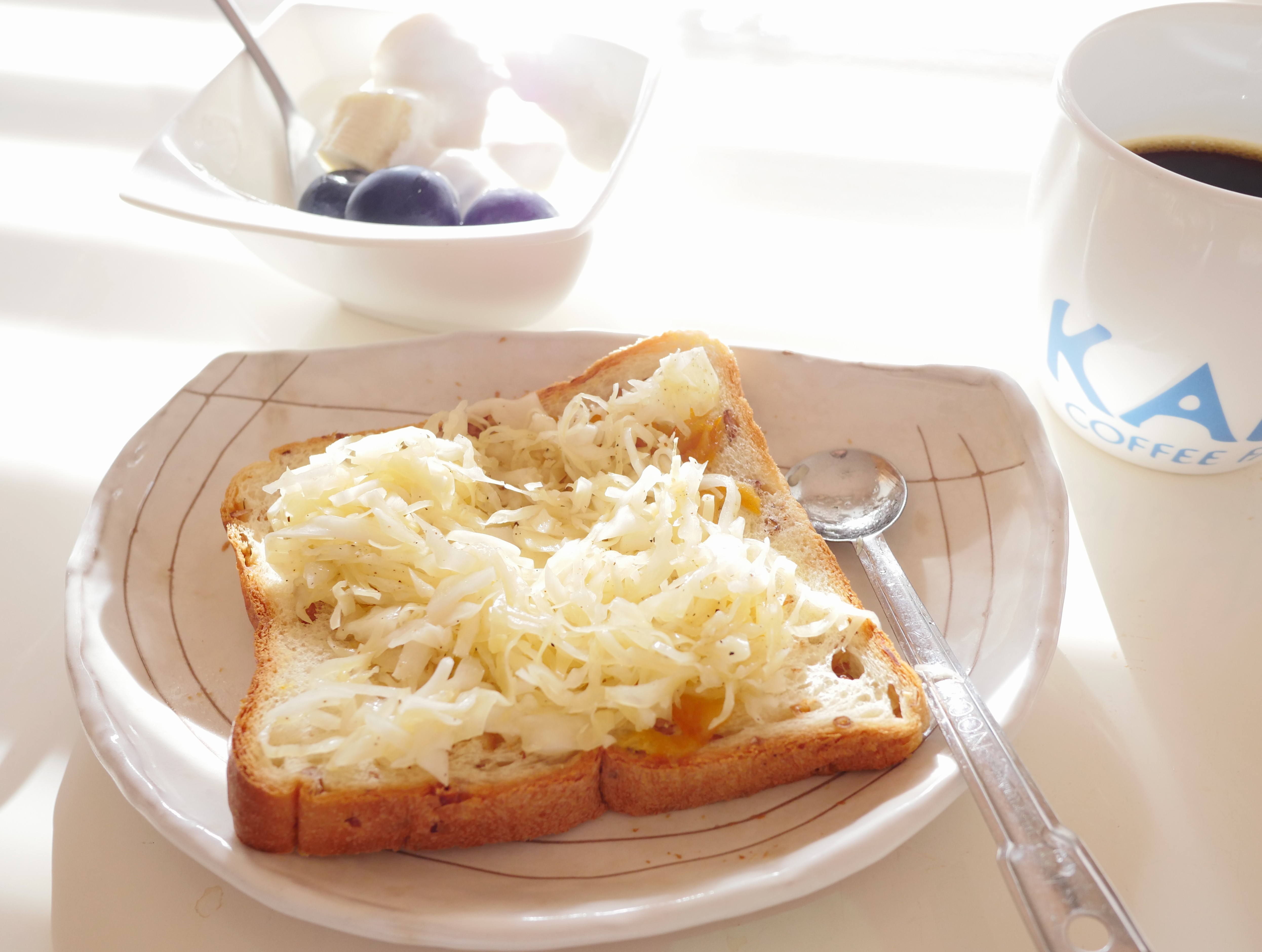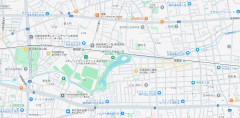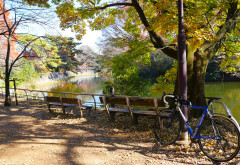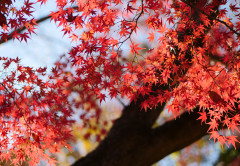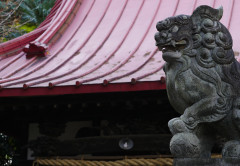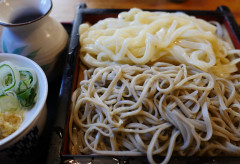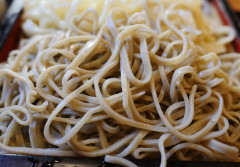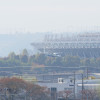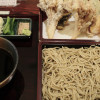Blog
秋のポタリング/Autumn Pottering Ride
温暖化の影響なのか、春と秋が年々短く感じられます。紅葉の本番はこれからですが、少し早めの紅葉狩りに出かけました。
今日のポタリングは、空堀川から逆瀬川沿いを走り、滝の城址公園を抜け、最後に平林寺のあたりで遅めの蕎麦をいただくという計画です。
西武池袋線をくぐったあたりから、雰囲気のいい川沿いの景色が続き、自然と心が落ち着いてきます。空堀川が逆井川と合流した後は、左手に小さな崖を見上げながら松柳橋を渡ります。この周辺では、羽を休める野鳥の姿をよく見かけます。今回は清瀬金山緑地公園側には寄らず、右岸をそのまま進むことにしました。川面に紅葉が映り込み、なんとも美しい景色です。
城前橋を渡って左岸に出ると滝の城址公園です。平日の昼間で人影はほとんどなく、ひっそりと紅葉が色づいていました。
そのまま武蔵野線をくぐり抜け、平林寺方面へ向かいます。平林寺の裏手には野火止用水が流れており、小川沿いの小道をゆっくりと進むことができます。野火止野鳥の森あたりでは、鬱蒼とした林の中で鳥たちのさえずりが響き、柿の木ではメジロが忙しそうに食事をしています。用水の奥では、鷺が人目を避けるようにじっと餌を狙っていました。
新座市役所はそこからほど近い場所にあります。その近くに、平日でも行列ができる蕎麦屋があると聞き、のぞいてみたところ、午後1時を回っているのにやはり行列ができていました。自転車を置く場所もなさそうなので、もう一軒の蕎麦屋に立ち寄ることにします。
暖簾をくぐると、こぢんまりとした空間ながら、昭和の品を感じさせる落ち着いた店構えです。写真かと思うほど精巧な切り絵が壁に飾られていました。
奥さまのご出身である岩手の水でいただく「水蕎麦」をすすめるお品書きが目に留まり、ご主人にガラス越しで、そばがき付きの「野火止そば」を注文しました。
しばらくして運ばれてきたのは、乳白色で水晶のような美しい更科蕎麦。ひと口すすると、こりっとした食感で、品のよいほのかな風味が広がります。待った甲斐のある、なかなか出会えない蕎麦でした。
食事を終えてお勘定を済ませると、店の横に置いていた自転車のサドルに白いビニールがかけられていました。何だろうと思ったところ、食事中に通り雨があったようで、自転車が濡れていたのです。「座るところだけですけど…」と裏口から出てこられた奥さまから声をかけていただきました。朝から雲の合間に晴れ間がのぞく天気でしたが、知らぬうちに雨宿りまでさせていただいたようです。
帰り道、一本の指だけ真っ赤に染まったように色づく紅葉に出会い、今日もいいことがたくさんあったなと、しみじみ嬉しくなりました。
Perhaps due to global warming, the seasons of spring and autumn feel shorter each year.The peak of the foliage is still ahead, but I set out a little early to enjoy the changing leaves.
Today’s pottering route follows the Karabori River, continues along the Sakasai River, passes through Takinojō Castle Ruins Park, and ends around Heirinji Temple for a late lunch of soba.
Once I passed under the Seibu Ikebukuro Line, a pleasant riverside view unfolded.The calm scenery along the water helped settle my thoughts.
After the Karabori River joins the Sakaisai River, I rode while glancing up at the small cliff on my left and crossed Sho-ryu Bridge.This area is a good place to spot birds resting by the river.Today I stayed on the right bank, without going toward Kiyose Kanayama Green Park.The reflections of the early autumn colors on the water were beautiful.
Crossing Jomae Bridge to the left bank brings you into Takinojō Castle Ruins Park.It was a quiet weekday afternoon, with almost no one around, and the trees were slowly beginning to show their reds and yellows.I passed under the Musashino Line and continued toward Heirinji Temple.
Behind the temple runs the Nobidome Irrigation Canal, and a small path follows the stream.Around Nobidome Bird Forest, the dense woods echoed with the sound of birds calling to one another.On a persimmon tree, Japanese white-eyes were busy pecking at the fruit.Farther down the canal, a heron stood motionless, waiting for prey where no one could see it.
The Niiza City Hall is just a short distance from there.I had heard that a soba restaurant nearby draws long lines even on weekdays, so I went to take a look.Even past one o’clock, the line was still there, and there seemed to be no place to park my bicycle.I decided to head to another soba shop.
Passing through the noren curtain, I stepped into a small but quietly refined space, with the atmosphere of the Showa era.On the wall hung delicate paper-cut artworks that could easily be mistaken for photographs.
An item on the menu recommended mizu-soba, served with water brought from Iwate, the owner’s wife’s home region.
Through the glass I ordered the “Nobidome Soba,” which came with sobagaki.
After a wait, a bowl of pale, milky-white sarashina soba was served—shimmering like crystal.Its gentle firmness and refined, subtle aroma made the wait worthwhile.It was the kind of soba one does not encounter often.
When I finished and went to fetch my bicycle, I noticed a white plastic cover placed over the saddle.I wondered what it was, but it seemed a sudden shower had passed while I was eating, lightly wetting the bicycle.
The owner’s wife came out and said quietly, “Just where you sit, but I covered it…”Her small kindness left me genuinely grateful.Though the day had been mostly cloudy with occasional sun, I ended up being given a bit of shelter without even realizing it.
On the way home, I came across a single branch of leaves—only one “finger” of the cluster—turned a brilliant red.It made me smile and think that today had brought more small blessings than I had expected.
食事と私/Food and Me
社会に出て定年まで食品業界で仕事をしていました。食べ物のおいしさを計る舌の感度には自信があるとは言えませんが、「一流」と言われるおいしいものを長年にわたって味わう機会は、人並み以上に恵まれていたと思います。
ただ、働き盛りのころは健康を考えた節度ある食習慣に無頓着で、朝食は抜き、昼食は大盛り、夕食は暴飲暴食という日々でした。体重は増え、コレステロール値は基準を大きく上回り、50歳を過ぎてからは薬に頼るようになっていました。
食のマーケティングを学びながら、生活者視点で「簡便でありながらおいしく健康的な食事」を提案するのが仕事でしたが、肝心の自分自身の食事や健康は後回しだったのです。
定年を迎えて以降は、それまでのルーズな食生活とは正反対に、健康的な食事を自ら作り、規則正しく食べるようになりました。いったい何がきっかけだったのでしょうか。
第二の職業に就いた現在も、余暇の時間は現役時代とさほど変わりません。コロナ禍を機に始めたそば打ちを、自宅で打って食べ、また打って…と繰り返すうちに、「料理する行為」から「味わうこと」まで、すべてが趣味のように楽しく感じられるようになりました。
そば打ちというひとつの行為を掘り下げる体験は、そば以外の料理にも応用が利きました。そば包丁で幅1.5mmに均等に切る作業や、菜切包丁でねぎを薄く輪切りにすることに慣れてくると、キャベツの千切りも、要領は違ってもボールペン字ほどの細さで切るのは簡単です。
そして何より、自分で作るとおいしく感じます。
そばのような繊細な食品は、機械による生産では加水量が制限され、流通やコストを考慮すると塩やグルテンなどの添加物を加え、そば粉の割合を減らさざるを得ません。そのため食感や風味にも影響が出てしまいます。
手打ちであれば、そば粉に少量の小麦粉と水を加えるだけ。めんつゆも、醤油・みりん・白ザラメで作った「かえし」に、鰹・昆布・しいたけのだしを合わせれば、体に沁みるようなうま味を感じます。
そばに限らず、材料にこだわった手作りの料理は、食材や調味料そのもののうまみや風味をじんわりと感じられます。素材の選定や配合を工夫することで、自分の好みや体調に合った食事を作ることもできます。
うま味調味料は便利ではありますが、先味の刺激が強く、私にはゆったりとおいしさを味わう感覚が薄れてしまうように感じます。醸造の過程でたんぱく質がほどよく分解されて生まれるペプチドによる、後味の長いうま味こそ、体に沁みて満足感を高めてくれます。
最近ではそば作りにとどまらず、朝食にもこだわるようになりました。
現在の定番は、スライスキャベツをサンドしたライ麦パンと、輪切りバナナ入りヨーグルトです。トーストしたパンに薄くバターを塗り、家内が作ったオレンジジャムをのせ、その上に味つけしたキャベツを挟みます。
キャベツは4分割して葉を3枚ほど取り、細かく千切りに。芯の部分は繊維に垂直に薄く輪切りにします。味つけは、オリーブオイル小さじ1杯を加えて混ぜ、きび糖小さじ1杯、米酢小さじ1.5杯、最後に塩コショウ少々。酢の酸味は慣れるまで強く感じるかもしれませんが、次第においしく食べられるようになります。
こうした積み重ねの結果、体調も良くなりました。便通が整い、血圧も安定しています。LDLを下げる薬は続けていますが、HDL値が改善しました。
このレシピを皆さんにお勧めするつもりはありません。
ただ、「自ら楽しみながらオリジナルの食事を創り、味わうこと」が健康な体づくりにつながることを知っていただければと思います。
タイパ(タイムパフォーマンス)の時代、食事づくりに手間をかける余裕は少ないかもしれませんが、できるだけ若いうちから週に一度でも「手作りの食事」に挑戦する習慣を身につけることは、きっと後悔しない大切なことだと、今になってつくづく感じています。
“Food and Me”
I worked in the food industry from the time I entered society until my retirement.
I can’t say I have a particularly refined palate, but over the years I was fortunate to experience many of the finest foods available.
However, during my busy working years, I paid little attention to healthy eating habits—skipping breakfast, eating large lunches, and often overindulging at dinner.
My weight increased, my cholesterol levels soared, and after turning fifty, I began relying on medication.
While studying food marketing, my job was to develop convenient, tasty, and healthy meal ideas from the consumer’s perspective.
Ironically, I completely neglected my own diet and health.
After retirement, I began doing the opposite of what I had done before—cooking healthy meals for myself and eating regularly.
I often wonder what brought about such a change.
Even after starting my second career, my schedule remained much the same as before.
During the COVID-19 pandemic, I took up soba noodle making as a hobby.
As I repeatedly made, cooked, and ate my own soba at home, I discovered that the entire process—from preparation to tasting—had become an enjoyable hobby in itself.
This focus on mastering the art of soba making turned out to be useful beyond soba.
Once I became comfortable cutting noodles evenly to 1.5 mm with a soba knife and slicing green onions thinly with a vegetable knife, I found that shredding cabbage—though requiring a slightly different technique—was just as easy, producing strands as thin as the line of a ballpoint pen.
And when you make food yourself, it simply tastes better.
Soba noodles are delicate, and in factory production the amount of water used is limited.
To meet distribution and cost requirements, manufacturers must add salt, gluten, or other additives, and often reduce the percentage of buckwheat flour.
These adjustments inevitably affect the flavor and texture.
When making soba by hand, however, you need only buckwheat flour, a little wheat flour, and water.
For the dipping sauce, combining a base made from soy sauce, mirin, and white sugar with a broth of bonito, kelp, and dried shiitake mushrooms produces a deep, soothing umami flavor that truly nourishes the body.
Handmade dishes that use carefully selected ingredients allow you to fully experience the natural taste and aroma of the food itself.
By choosing your ingredients and adjusting the proportions, you can create meals suited to your own preferences and health.
Seasoning enhancers such as monosodium glutamate are convenient, but their initial sharpness makes it difficult for me to relax and savor the flavor.
In contrast, the long-lasting umami that comes from peptides produced through fermentation feels more natural and deeply satisfying.
Lately, my culinary interests have expanded beyond soba to include breakfast.
My current morning routine consists of rye bread sandwiches with shredded cabbage, and yogurt topped with banana slices.
I lightly toast the bread, spread a thin layer of butter, add homemade orange jam made by my wife, and place the seasoned cabbage between the slices.
To prepare the cabbage, I quarter it, finely shred about three leaves, and slice the core thinly across the grain.
For seasoning, I mix in one teaspoon of olive oil, one teaspoon of raw cane sugar, one and a half teaspoons of rice vinegar, and a pinch of salt and pepper.
At first, the vinegar may taste a bit strong, but you’ll soon come to enjoy its freshness.
Through this daily routine, my body has felt better overall—my digestion improved, my blood pressure stabilized, and while I still take medication to lower LDL, my HDL levels have increased.
I’m not suggesting that everyone follow this exact recipe.
What I truly hope to convey is that creating and enjoying your own original meals can lead to better health and a deeper appreciation of food.
In this era of “time performance,” people may feel they don’t have the luxury to spend much time cooking.
Yet I believe that cultivating a habit of preparing a homemade meal even once a week—especially while you are still young—is something you will never regret.
That’s what I have come to realize, with a sense of reflection and gratitude.
年末のポタリング/Pottering Before the Year Ends
2024年も残り2週間。東京も12月中旬に入り、ぐっと気温が下がってきました。我が家の「めんつゆ」は、実家向けの年越しそばと一緒にタレビンに入れて発送済み。残りもわずかになったので、年内にもう一度仕込む必要があります。「かえし」、利尻昆布、香信椎茸甲信椎茸の在庫は十分。あとは鰹節を買うだけです。
築地に出かける余裕はないので、Googleマップで三多摩地区の鰹節屋を検索。東伏見に創業50年を超えるお店が見つかりました。せっかくなので、武蔵関公園を散策し、近くの「たから」という蕎麦屋で昼食を取る計画を立てました。
当日は朝から冷え込み、電車にするか迷いましたが、澄んだ青空と暖かな日差しに誘われて自転車で出発。新青梅街道を東へ進み、伏見通りを越えてすぐ右折。西武新宿線の下をくぐって左折すると、東伏見稲荷参道に出ます。
参道を少し進むと、歴史を感じさせる老舗の店構えが左手に見えました。ところが、「11月閉業」の貼り紙が…。少し寂しい気持ちになりながらも、自転車と記念撮影をして次の目的地、武蔵関駅方面へ向かいます。
東伏見駅から線路沿いを進むと、武蔵関公園の入り口が見えてきました。階段を降りると、富士見池を背景に鮮やかな紅葉が広がっています。池の水面に映る紅葉は光を受けてキラキラと輝き、思わず見とれてしまうほど。
鳥たちのさえずりがあちらこちらから聞こえ、突然、別世界に入り込んだような気分になります。西武線の電車が頻繁に行き来しますが、不思議と気になりません。しばらく紅葉の写真を撮り、心が満たされたところで天祖若宮八幡宮に立ち寄りお参りをしてから、蕎麦屋へ向かいました。
武蔵関駅の南口を過ぎると、「たから」の看板が見えてきました。窓越しに見える長身のご主人が、手際よく仕事をしています。戸を開けると、昭和の香りが漂う店内。おとなしい雰囲気のおばあちゃんが、お茶を出してくれました。腰が大きく曲がっています。
メニューを見て、「肉せいろうどんと蕎麦を一緒にした『あいもり』はできますか?」と聞くと、奥からご主人の声。「肉せいろ(豚肉)は蕎麦には合わないからね」。なるほどと納得し、普通の「あいもり」を注文しました。
運ばれてきたうどんと蕎麦は、どちらもコシがしっかりしていて絶品。うどんはほんのり黄色みがかり、甘めのつゆとよく合っています。昭和の風情漂う店で、心が温まる一品でした。
帰りは新青梅街道をひたすら西へ。1車線ですが道幅は広く、自転車でもストレスなく走れます。鰹節はどこで買おうか…。そんなことを考えつつ、最近ハマっている「真夜中のドア」を口ずさみながら自宅に戻りました。
寒い中のポタリングでしたが、美しい紅葉や昭和の香り漂う蕎麦屋での昼食、そして計画外の出来事を楽しむことができました。やっぱり旅は、こうした小さな発見と偶然の出会いが醍醐味ですね。
Pottering to Buy Katsuobushi Before the Year Ends
With just two weeks left in 2024, the temperatures in Tokyo have dropped significantly as mid-December arrives. The mentsuyu stock at home, which I had bottled and sent with soba noodles for my family’s New Year’s celebration, is now running low. It’s time to make another batch before the year ends. I have enough kaeshi (soy sauce base), Rishiri kombu, and Koshin shiitake (Dried Japanese Mushroom)—what’s missing is katsuobushi (dried bonito flakes).
Since I don’t have time to go all the way to Tsukiji, I searched Google Maps for katsuobushi shops in the Tama region. I found one in Higashi-Fushimi, a store with over 50 years of history. I decided to visit the shop the following day, combining the trip with a stroll through Musashiseki Park and lunch at a nearby soba restaurant called “Takara.”
Setting Off for Higashi-Fushimi
That morning, it was freezing, and I debated whether to take the train. But the clear blue sky and warm sunlight convinced me to ride my bicycle instead. Heading east on Shin-Oume Road, I passed Fushimi Street, turned right, and after going under the Seibu Shinjuku Line, I turned left onto the Higashi-Fushimi Inari Sando (approach road).
A little further along the approach, I spotted an old, historical-looking shop on the left. Unfortunately, there was a sign that read “Closed as of November.” Feeling a pang of sadness, I took a commemorative photo with my bike before heading toward Musashiseki Station.
The Autumn Leaves at Musashiseki Park
From Higashi-Fushimi Station, I cycled along the train tracks until I reached the entrance to Musashiseki Park. Descending the stairs, I was greeted by a stunning scene of autumn foliage reflected in the Fujimi Pond. The vibrant red and yellow leaves shimmered in the sunlight, creating a breathtaking view.
Birds chirped from every direction, and it felt as if I had wandered into a different world—calm and peaceful. The frequent passing of Seibu trains somehow didn’t disturb the tranquility. After taking a few photos of the scenery and fully soaking in the atmosphere, I stopped by Tenso Wakamiya Hachiman Shrine to pay my respects before heading to the soba restaurant.
"Takara’s Aimori: Udon and Soba Combo"
Past the south exit of Musashiseki Station, I spotted the sign for “Takara.” Through the window, I could see the tall owner diligently working. When I entered, I was welcomed by the nostalgic charm of a Showa-era interior. An elderly woman, likely in her 80s, quietly served me tea. Her back was noticeably bent, a testament to her age.
Looking at the menu, I asked if I could order a combination of niku seiro udon and soba (aimori). From the back, the owner’s voice rang out: “Niku seiro (pork)doesn’t pair well with soba.” Accepting his wisdom, I ordered the standard aimori.
Both the udon and soba that arrived were outstanding, each with a satisfying firmness. The udon had a slight yellow hue and paired beautifully with the sweet dipping sauce. Sitting in this old-fashioned soba shop, I felt warmth from the nostalgic atmosphere itself.
Heading Home Feeling Refreshed
On the way back, I rode west along Shin-Oume Road. Although it’s only one lane, the wide road made cycling stress-free. I mused over where I should buy katsuobushi while absentmindedly humming my current favorite song, “Mayonaka no Door,” feeling content as I pedaled home.
In Conclusion
Despite the cold, this pottering trip offered beautiful autumn foliage, a delightful soba lunch steeped in Showa charm, and a series of unexpected yet pleasant experiences. After all, the real joy of a journey lies in discovering the small wonders and embracing the surprises along the way.
今流の楽しい人生の過ごし方とは/How to Enjoy a Modern and Fulfilling Life
人生は旅のようなもの。誰もが「後悔のない、有意義で楽しい旅をしたい」と考えるのではないでしょうか。旅の楽しみ方は人それぞれです。僭越ですが私の楽しみ方とある日の小さな旅のことをお話ししたいと思います。
私の趣味は、休日に自転車で蕎麦屋を訪ねることです。計画は、仕事帰りなどに頭の中でおおまかに考えます。距離は往復30㎞、移動時間は約3時間、食事時間を含めて3時間程度の「ポタリング」が基本です。
初めにどの方面のどの蕎麦屋に行くかを決めます。グーグルマップを開き、行きたい方面のエリアを画面に映して、「そば屋」を検索すると地図上には屋号、画面左手には検索結果の一覧(屋号のほか評点・住所・営業時間)が表示されます。評点4点以上のお店をピックアップしてクチコミを読みます。必要に応じ写真や食べログのページも参考にして自分が行ってみたいお店を絞り込みます。
次に、コースを考えます。マップ上の道をクリックし道の状況を写真で確認します。自転車が走りやすい道かどうかが分かります。車が通ることができない遊歩道や川沿いの道は優先して検討します。自宅から目的地までのコースをマップ上に表記させて走行距離や高低差なども確認します。寄り道したい場所もチェックします。工程が決まったら、マップを白黒でプリントし、曲がる箇所に赤ペンで矢印を書き込んでいきます。スマホは持参しますが、地図に手書きでメモを入れると頭にインプットできます。
ある日のプランでは、多磨霊園近くのそば屋を目指しました。寄り道の目玉は野川沿いにある評点4.7の「崖(はけ)の道遊歩道」です。
その日は小春日和の暖かな日でした。天文台通りを右折し、野川沿いの道を少し走ると右手に住宅街が広がるエリアへ入っていきます。遊歩道の入口がみえてきました。自転車を押しながら、急な階段を登り始めます。旧多摩川が作り出した崖線を一気に駆け上がると平地にたどり着きました。
遠くに味の素スタジアムを眺めていると、その手前で小型飛行機がエンジン音を響かせながら着陸する様子が目に入りました。その先に調布飛行場が広がっているようです。今日は望遠レンズも持参しているので、飛行場をじっくり観察してみようと思い立ちました。崖線の下りは、土の遊歩道です。薄暗い竹藪の中を通り過ぎ再び野川に出ます。滑走路を見下ろせる「展望の丘」はそこからすぐでした。背後から突然爆音とともに小型プロペラ機が降りてきます。まぶしいほどの滑走路に飛行機がのんびりと離着陸をする風景をぼんやりと眺めていました。予定より遅くなりましたが、1時過ぎにはそば屋に着くことができそうです。武蔵野の森公園を通り過ぎ人見街道を進むとすぐに店前に到着しましたが、臨時休業の貼り紙がありました。マップには営業中と表示されています。このようなことは何度か経験しているので腹は立ちません。遠回りして以前行ったことがあるお気に入りのそば屋にするか、クチコミの内容が好みに合わずまだ訪問していないお店にするか考えましたが、近道の後者に決めました。
小金井街道を通り抜け駅近くの駐輪場に自転車を止めます。お店は琴の音が流れる品の良いおそば屋さんでした。お薦めの舞茸天ぷら付きもりそばを注文します。天ぷらは、揚げたての熱々でサクサクッと噛むと溶けていく感じです。食材の風味とうまみが気持ちよく鼻からぬけていきます。本物の天ぷらでした。蕎麦は、角が立っていて、黒目。九割そばでしょうか、新蕎麦の香りと味をしっかり感じることができる細麺の本格派です。これほどまでおいしい天ぷらと蕎麦を戴けるとは思いもせず、とても満足な昼食となりました。
このポタリングで印象的だったのは、予定外の体験ができたことです。飛行場の風景を眺め、素晴らしい蕎麦に出会うことができました。実際に旅をするときに、あらかじめ過多の情報を持っていると想像力が削がれますし、情報とは違うことにも遭遇もします。最先端の技術を利用しつつ、現地での体験を通じて偶然の出会いを楽しむ。このバランスが楽しい人生を創るコツではないかと感じました。評点やクチコミは、ほどほどの利用がよさそうです。
いずれにしましても旅も人生も計画通りうまく進まないのが常のようです。ただ、その中で想定外の幸運に巡り合うこともあります。その積み重ねがひとりひとりのかけがいのない人生になるのだと思います。
How to Enjoy a Modern and Fulfilling Life
Life is like a journey. Everyone wishes for a meaningful and enjoyable trip with no regrets. The way to enjoy this journey varies from person to person. Allow me to share how I spend my time and recount one of my small adventures.
Cycling to Soba Shops: My Hobby
On weekends, I enjoy visiting soba shops by bicycle. I roughly plan my trips during my commute home from work. Typically, I aim for a round trip of about 30 km, with a total duration of around three hours, including the meal. This leisurely cycling style is known as pottering.
First, I decide which soba shop to visit. I open Google Maps, display the desired area, and search for "soba shops." The map displays shop names, while the sidebar lists results with ratings, addresses, and opening hours. I select shops rated 4 stars or higher, read reviews, and sometimes refer to photos or dining websites like Tabelog to narrow down my options.
Next, I plan my route. By clicking on the roads in the map, I check their conditions to see if they are suitable for cycling. I prioritize bicycle-friendly paths, such as promenades or riverside routes where cars cannot pass. I also plot the distance, elevation, and potential detours for sightseeing. After finalizing the itinerary, I print a black-and-white map and mark turns with red arrows. While I carry my smartphone, manually marking the map helps commit the route to memory.
A Sunny Day's Adventure
On one such outing, I planned to visit a soba shop near Tama Cemetery. The highlight of the route was the "Hake-no-Michi Promenade," a riverside path with a remarkable rating of 4.7 stars.
The day was warm and sunny. I cycled along Tenmondai Street, then turned toward a residential area near the Nogawa River. Soon, I found the entrance to the promenade—a steep staircase leading upward. Pushing my bicycle alongside me, I climbed the stairs carved into the geological escarpment formed by the old Tama River. Reaching the top, I was greeted by flat terrain and a stunning view of Ajinomoto Stadium in the distance.
The scenery became even more intriguing when a small aircraft roared into view, landing gracefully on a hidden runway at Chofu Airport. Intrigued, I decided to explore further, equipped with a telephoto lens for closer observation.
Descending the escarpment, I followed a dirt path through a dim bamboo grove, reemerging at the Nogawa River. Shortly after, I arrived at "Observation Hill," where I could overlook the runway. I spent a peaceful moment watching small planes leisurely take off and land under the bright sunlight.
Discovering a New Soba Shop
Running behind schedule, I hurried toward my destination, only to find a sign announcing temporary closure. Though Google Maps had indicated the shop was open, I wasn’t upset. Instead, I calmly weighed my options: revisit an old favorite or try a yet-unexplored shop on my way back. Opting for the latter, I pedaled along Koganei Street toward the station.
The shop I found was elegant, with the gentle sound of a koto playing in the background. I ordered their recommended mori soba with freshly fried maitake mushroom tempura. The tempura was piping hot and crispy, crumbling softly as I bit into it. The rich aroma and umami filled my senses. The soba itself was a masterpiece—dark-hued, square-edged, and likely made from 90% buckwheat flour (kyu-wari soba). The fresh buckwheat aroma and refined taste of the thin noodles left a deep impression. It turned out to be an unexpectedly satisfying lunch.
The Joy of Unplanned Experiences
This pottering adventure was most memorable for the unplanned experiences. I delighted in the serene airport view and discovered a fantastic new soba shop. While modern tools like Google Maps provide valuable guidance, having too much information beforehand can stifle imagination. Discrepancies between expectations and reality often lead to delightful surprises. Balancing the use of advanced technology with firsthand experiences and embracing chance encounters may be the key to a fulfilling life. Moderation is essential when relying on ratings and reviews.
In both travel and life, plans seldom unfold perfectly. Yet within those deviations lie unexpected joys and fortunes. These moments accumulate to form each person’s unique and irreplaceable journey through life.
